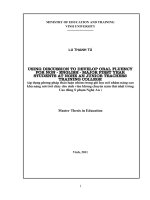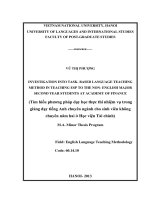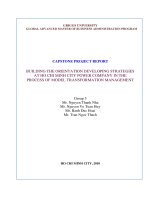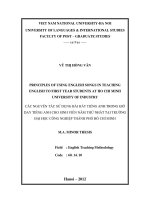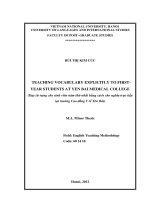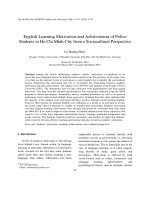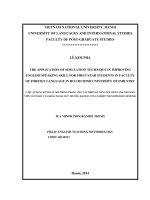Principles of using English songs to teach English to first year students at Ho Chi Minh University of Industry
Bạn đang xem bản rút gọn của tài liệu. Xem và tải ngay bản đầy đủ của tài liệu tại đây (249.18 KB, 14 trang )
Principles of using English songs to teach
English to first year students at Ho Chi Minh
University of Industry
Vũ Thị Hồng Vân
Trường Đại học Ngoại ngữ
Luận văn Thạc sĩ ngành: Lý luận và phương pháp giảng dạy tiếng Anh
Mã số: 60.14.10
Người hướng dẫn: TS. Tô Thị Thu Hương
Năm bảo vệ: 2012
Abstract: This study aims at setting up some principles of using English songs to
teach English to first year students at Ho Chi Minh University of Industry. Based on
Tomlinson’s principles of materials development, previous studies on using songs in
language teaching and teachers’ real situation of using songs as teaching material at
HUI, the researcher has established some principles which mainly focus on three
issues: identifying clearly the goals of using songs, choosing songs and designing
tasks from songs properly. The principles then were applied into real teaching at HUI
and the result was quite feasible. The students’ evaluation form has shown that the
principles have had positive effect on language teaching and learning at HUI. In
conclusion, establishing and following the principles of using songs is a “should do
job” to HUI teachers if they want to achieve and enhance the pedagogical benefits of
English songs in language classroom. However, due to researcher’s limited ability and
experience, the principles can not cover all aspects; teachers should always keep
trying, experimenting new ways of using songs and extending new using songs
principles.
Keywords: Tiếng Anh; Phương pháp giảng dạy; Bài hát
Content
PART 1: INTRODUCTION
1. Rationale
As a result of the globalization, English nowadays is playing a more and more
important role in helping people to communicate with others from all over the world. Being
aware of this importance of English, all schools in our countries are putting more and more
emphasis on teaching this language. Like other universities, English is being taught at our
university as a compulsory subject; therefore English counts for as many credits as the
majored subjects. Contrary to the long duration of learning English is the lack of motivation
as well as interest in learning English of the students at our university. This is quite easy to
2
understand because most of the students at our university are non-majored English students.
Their English proficiency is quite low as a result of the passive, test-oriented learning style at
their high school that is just focusing on the main subjects taken in the entrance examination
to the university. In addition, teaching and learning method is also a cause of the students’
demotivation of learning English. Regarding the teaching methods, most of the English
teachers still keep the traditional teaching approach which focuses on grammar and
translation. The English lessons are said to be boring, tiring and sometimes even tense. Being
aware of this negative learning and teaching condition, many teachers in our university are
trying to change their teaching method by integrating different teaching approaches and using
more interesting teaching aids such as pictures, flashcards, PowerPoint, games, stories and
songs. Among those, songs seem to be the most popular to students and also more frequently
used by teachers than others. However, the effectiveness gained through using songs is still
not high as expected. Although songs have been proved to be a very interesting teaching
materials and have been applied in teaching in many European countries, this method still
seems to be a new one for Vietnamese teachers in general and the teachers at Ho Chi Minh
University of Industry (HUI) in particular. Most teachers still meet difficulties in working out
the way to exploit the maximum benefits of songs in English classroom. It seems that teachers
just spontaneously use English songs as an entertaining tool to relax students not a teaching
aid. Teachers fail to set a particular pedagogical aim or follow a specific rule of using songs.
Generally, songs are often played at the end of the lesson when teaching and learning is
finished and students are sitting to wait for the bell rang. Sometimes teachers also let students
listen to English songs at break time; hence not all students pay attention to the songs.
Sometimes songs are also put in the course books as an extra task such as listen to the song
and fill in the blanks. However, teachers tend to have different ways of carrying out this task.
While some teachers ignore this task and just let students sit and enjoy the music, other
explain the instruction and let students listen to the song, get them to finish the task and then
check as an exercise. They rarely explain what students can learn from the songs or have no
further activities or tasks for the students after having students listened to music. Therefore
students often forget the song right after listening or even if they are interested in the song,
they do not know what to do with it. In short, for most of the students at my university, they
just regard songs as a means of entertainment not a useful tool/source of learning English. For
teachers, most of them have not succeeded in exploiting the pedagogical benefits of English
songs except for the entertaining and relaxing benefits. As a teacher of English at the
university, I am also very interested in using songs as a teaching aid in English lessons.
3
Learning that at present, songs are not effectively used in teaching English at HUI, I myself
realize that in order to get optimal benefits from using English songs as a teaching tool, there
should be some principles of using songs to teach English to guide teachers.
2. Aims of the study
(1) setting out the principles of using English songs to teach English to first year HUI
students through empirical research, i.e. HUI English teacher survey and student evaluation;
(2) finding out the feasibility of applying these suggested principles of using songs to
teach English to first year students.
3. Scope of the study
The study mainly focuses on finding out the principles of using songs to teach English to first
year students at Ho Chi Minh University of Industry. It, therefore, does not focus on exploring
the effectiveness of the principle application.
4. Method of the study
1. Teachers’ questionnaire
2. Evaluation questionnaire for students
The data collection process lasted 2 weeks (teacher questionnaire) and in the last week
(student evaluation) during the first term of the academic year 2012- 2013.
5. Design of the study
This study contains three main parts as follow:
Part 1 is the introduction in which I would like a present the rationale of choosing this
topic, the aim of the study, the scope of the study and the methods to be applied.
Part 2 is the development which includes three main chapters:
Chapter 1 is about the theoretical background related to the purpose of the
study
Chapter 2 deals with investigating the situation of using English songs in
teaching at HUI and finding out the principles of using songs to teach English
for first year students at Ho Chi Minh University of Industry
Chapter 3 is concerned with applying the proposed principles of using songs in
teaching English at HUI and then evaluating the feasibility of these principles
when applied in real teaching at HUI.
Part 3 is the summary of the major findings in Part 2 and suggestions for further study.
This part also contains the List of References and Appendices.
4
PART 2: DEVELOPMENT
CHAPTER 1: LITERATURE REVIEW
1. Reasons why English songs should be used as teaching materials.
- Affective reason
- Cognitive Reasons
- Linguistic Reasons
2. Materials in foreign language learning and teaching
According to Brian Tomlinson (1998), “material” refers to “ anything which is used
by teachers to facilitate the learning of a language”. From this point of view, songs are also
considered teaching materials which can effectively support the teaching of foreign language.
3. Principles of developing teaching materials
3.1. Materials should achieve impact
3.2. Learner’s attention should be drawn to linguistic features of the input.
3.3. Materials should provide the learners with opportunities to use the target language
to achieve communicative purposes.
3.4. What is being taught should be perceived by learners as relevant and useful.
3.5. Materials should take into account that learners differ in learning style and affective
attitude
3.6. Materials should help learner feel at ease and develop confidence
4. Previous studies on using songs to teach English
4.1. Teaching grammar
Regarding the studies which focusing on using songs to teach grammar, there have
been many researches such as research by Ha (1999), Thu ( 20005). These researches have
shown that songs are beneficial for teaching grammar and the two authors give some elements
that help teacher choose songs such as: appropriate length, rhythm, lyrics and content,
students’ level, students’ age, students’ interest, grammar points to be studied and
features of the song. According to Thu (20005) songs can be used for all of the phrases in
grammar lesson such as warming up, presentation, practice and production. Ha (2005)
suggested a lot of interesting activities with songs such as identifying particular parts of
speech, giving the right form of the words in the brackets, multiple choice, blank filling, and
creating new lyrics and so on
5
4.2. Teaching Vocabulary
Chuanxuan Shen (2009:5) explains that when coming across an impressive song,
learners will be eager to understand the content and sing after the singer or sing it themselves.
This leads to their further motivation to learn all the new words appearing in the song. By this
way, their vocabulary will be naturally improved. Thorn Bury (2002) adds that “In lyrics,
words usually appear in context, the sound of new words is easily remembered along with the
melody of the song and by listening to the song, students are exposed the new words many
times”. Definitely, the usefulness of songs to teaching and learning vocabulary is undeniable.
This has been affirmed in the research of Huyen (2002) and Chuanxuan Shen (2008), however
not many suggestions on designing tasks for teaching vocabulary were mentioned in these two
studies. Dagmar Siskova (2008) recommends that “ for teaching vocabulary, the most
appropriate activities are writing a dialogues using the words of the song, dictating a
song, using a song for gap-fill, cloze, or correction, using songs into project work,
practicing songs for pronunciation, intonation and stress”.
4.3. Teaching Pronunciation
Veronika Rosova (2007) concludes that songs can be of great help in teaching three
areas of difficulties in pronunciation, namely sounds, words and connected speech. To be
detailed, Veronika claims that “the rhymes in songs provide listeners with the repetition of
similar sounds, and when students choose to listen to the song again and again, they are
exposing them to these sounds, repeating them, getting better at recognizing them and
producing them”. For learning words, In Veronika’s opinion, songs fitting the music and
containing memorable rhythms can help students associate with the syllables, the stress in
the words.
Besides, songs can be useful for teaching three other elements of pronunciation such as
word stress, rhythm and intonation (Mai: 2010).
4.4. Teaching listening
Researchers both nationally, Huyen (2002: 68), Huyen (2006), Trang (2006) and
internationally De Kock (1989:123), Fiveash (1989:195), Lynch, L.M (1993:23), James
(2000: 36-37) and many others suggest the use of music to enhance students’ listening
proficiency. Music provides students with practice listening to different forms of intonation
and rhythm.
4.5. Teaching speaking, writing and reading
Chuanxuan Shen (2009) demonstrates that singing an English song demands
familiarity of a number with phonological rules such as liaison, loss of explosion,
6
assimilation, voicing, deletion, and so on which help students enhance their speaking fluency.
According to Shen (2009), songs also help refresh the boring atmosphere in writing lesson.
Teacher can ask students make a new version of the original song on their own by following
the same tune, imitating the format of the lyrical lines. Therefore, writing the lyrics by
imitation might be a effective way of digging out students’ creativity in language. The right
song will arouse their empathy, stimulate their inspiration and light their passion to express
their experiences and emotion in the same way.
CHAPTER 2: A STUDY ON USING SONGS AS TEACHING MATERIAL IN
TEACHING ENGLISH TO FIRST YEAR SUTDENTS AT HUI AND SUGGESTED
PRINCIPLES OF USING SONGS TO TEACH ENGLISH
1. Research approach and questions
The study was mostly qualitative using questionnaire survey, complemented with
student evaluation. The questions set for the survey were:
1. What are HUI English teacher’s attitudes toward the use of English songs in their
teaching?
2. How do they often use English songs to teach English?
3. What is the effect of teaching English with songs on their students’ language proficiency?
4. What are their difficulties when using songs to teach English?
5. What solutions do they suggest for the problems of using songs to teach English?
2. Participants
The study was carried out with the participation 20 English teachers coming from Ho Chi
Minh University of Industry.
3. Data collection instrument
Questionnaire for teachers
This research was conducted as a qualitative study, using questionnaire for teachers.
The questionnaires for teachers are used to investigate the necessity of using songs in
language classroom, the way teachers use English songs in language classroom, the
difficulties that they may encounter while using songs and to search for solutions to those
difficulties.
4. Procedures of data collection
The information was collected within one week in the third semester of the school year
2011 – 2012.
5. Data analysis
7
Data from questionnaires were analysed quantitatively via Excel for descriptive
statistics in the form of pie chart, percentage and frequency. Data from student evaluation was
analysed interpretively to gauge the feasibility of the principles putting into practice.
6. Results of data analysis
The statistics in the data analysis have showed that most of the English teachers have
been aware of the importance and usefulness of English songs in language learning and
teaching. Therefore, more than half of them use English songs in language classroom.
However their use just mainly focuses on motivating and helping students relaxed. Besides,
English songs are also exploited to teach listening, pronunciation; nevertheless the percentage
of those who use songs to teach grammar, speaking, reading or writing is not high. This
means that the way teachers handle with English songs in language classroom is not very
diverse. This can be an existing limitation that is the teachers haven’t either grasped a full
understanding or made an optimal use of the pedagogical value of songs in language teaching.
One more thing revealed through the data analysis is that there are not many activities and
tasks associated with songs for students to get involved in. This is another limitation that can
reduce the effect of English songs on students’ language acquisition and improvement. Most
of the time, teacher just play songs and let students sit passively to enjoy the music. Not stop
there, teachers when using songs have to cope with a lot of difficulties, especially in choosing
and designing tasks from songs. Additionally, students’ low ability of listening and speaking
as well as the limited time in the class can also lead to the low efficiency of using songs in
language class. What’s more, many teachers complain that big class size is also a challenge
for teachers (more than 50 students in a class). Teachers find it difficult to control students as
well as the noise when playing songs in the class.
The discussion above suggests that it is necessary to establish some basic principles of
using songs for teachers to follow so that they can achieve their teaching purpose. The
principles can focus on three main issues namely identifying the aims of using songs,
choosing songs and designing tasks from songs.
8. Suggested principles of using songs in teaching English
Principle 1- Songs should achieve impact on learners in alignment with course/lesson
objectives
- Songs have to meet students’ need, curiosity, interest and
Principle 2- Songs should be used to enhance learners’ language development
8
- Language proficiency needs to strengthen learners’ language components such as:
grammar, vocabulary and pronunciation and language skills such as listening, speaking,
writing and reading.
Principle 3 - Teachers should take the difference of learners’ learning style and affective
attitude into consideration.
Brian Tomlinson (1998) has pointed out the necessity for teachers to understand their
student’s preferable way of learning before deciding to use songs as a teaching aid in the
class. Not every student is interested in learning with songs. For those students who belong to
the group of “auditory”, “kinaesthetic” or “experiential”, songs appear to be a good choice.
Principle 4 - Songs should be properly chosen.
Teachers should consider carefully some elements such as songs’ features, student’s
features and the goal as well as the topic of the lesson before choosing them.
Songs’ feature: music type, length, speed, linguistic content and features
Student’s factor: interest, age, English proficiency and learning style
The goal and topic of the lesson: Songs chosen should be based on the goal and topic of the
lesson
Principle 5 - Pedagogical tasks should be appropriately designed for use with songs.
1. Teachers should design appropriate tasks based on the language aspect to be taught,
the songs and students’ level.
The tasks designed should focus on the language aspect that teacher is going to teach
in the lesson.
In order to design the tasks suitably and effectively, teachers also shouldn’t forget to
consider some factors such as song’s lyrics, vocabulary, difficulty level, the rhythm and
speed, students’ level, the difficulty level of the tasks
2. Tasks and activities associated with songs should help learners feel at ease and
develop confidence
It’s advisable for teachers to avoid choosing too long or difficult songs or designing
too difficult tasks; otherwise learners will feel tense or worried to finish the tasks and may no
longer feel interested in learning with songs next time.
CHAPTER 3: PRINCIPLES OF USING SONGS IN TEACHING ENGISH TO
FIRST YEAR STUDENTS AT HUI: AN APPLICATION AND EVALUATION
1. Putting the principles into use: teaching English to first year students at HUI
9
In order to evaluate the feasibility and suitability of the suggested principles in English
teaching and studying at HUI, the researcher has applied those principles into her actual
teaching of two English classes: basic English one and basic English two.
1.1. Some description of the pilot classes
The total number of two English classes is 100 students. Most of them are at the age of
19. Their English level is pre- intermediate
1.2. Procedure
The researcher used songs to teach English to two classes in two weeks in the first
semester of the new school year 2012 -2013. Each week there were two lessons and in each
lesson, the researcher both used English songs to teach different language aspects such as
grammar, listening, and vocabulary. The researcher used the principles of using English songs
as a guide line.
1.3. The application of the principles of using songs
Based on the principles, I decided to use the song “Love concerto” to enhance my
students’ vocabulary. To be detailed, through using the song, I can help my students
consolidate the use and grasp the difference between “adverb” and “adjective” in an
interesting way.
Before using song, I also considered whether my students are interested in learning
with songs or not.
Regarding the principles of choosing songs, I also studied very carefully three main
factors that help to choose suitable songs. I find that the song “Love concerto” is a suitable
one with slow rhythm, clear pronunciation, interesting and understandable content. Besides,
the lyrics of the song contain a lot of adjective and adverb which is related to the content of
the lesson. So students can enjoy the music and learn at the same time.
Taking the principles of designing tasks from songs into consideration, I am aware that
the designed tasks should meet some requirements such as helping learners feel at ease,
relating to the linguistic input to be taught and providing learners with opportunities to use the
target language to communicate.
A SAMPLE LESSON PLAN
2. Evaluation of the feasibility and suitability of the proposed principles in teaching
English at HUI
2.1. Procedure and data collection instrument
After applying the principles of using songs to teach English to two classes at HUI, the
researcher delivered an evaluation form to students in two classes to check out whether these
10
principles are suitable and useful or not. The researcher herself reflected on the feasibility of
the application, then discussed with the head of EFL section and other fellow teachers for
their confirmation.
Evaluation form for students
The evaluation form was created for students with the aim of checking whether the
applied principles of using English songs in language classroom work or not. Students are
expected to express their attitudes and opinions on the effect of using English songs in
language classroom on their language learning motivation as well as language proficiency in
the three first questions. The next two following questions aim at finding whether teachers
have applied the principles of choosing songs and designing songs properly or not and the last
one asks about the students’ general opinion on the lesson with the use of English songs:
whether they satisfy or not and why.
2.2. Data analysis and discussion
a. The effect of using English songs on students’ learning motivation
It can be seen from pie chart 4 that using English songs in class room has positive effect
on students’ learning motivation with 85% of students agreeing that using songs motivate
them to learn English.
b. The effect of using English songs on students’ language proficiency
When being asked about the effect of using songs on learners’ language proficiency
based on the top down degree: very much, much, not much and not at all, 28% choose very
much, 38% choose much while 13 % choose not much and other 21% claim that the
interference of English songs in class has no effect on their language development.
Among 79 students agreeing that learning with English songs help them improve the
language components and language skills, 66% of them state that listening is the skill that is
enhanced most through songs. Ranking the second is pronunciation with 66% of them
choosing. Following vocabulary is pronunciation with 62%. Grammar is also enhanced quite
much through songs with 59% of the students. Although speaking, writing do not have high
percentage like others, they are still claimed to be improved with the use of songs with the
percentage respectively, 29 %, 12%. The only skill that seems not to get much positive effect
from songs is reading with 10% of the learners choosing.
b. Choosing songs and designing tasks from songs
Result gained though the evaluation form show that songs were chosen properly with
84% of students answering “yes” to the question “are the songs chosen properly”.
11
Question 5 asks whether the teacher has designed songs properly or not and there were
79% of the students saying that most of the tasks were designed suitably with their level as
well as the aim of the lesson.
c. Students’ general attitude toward the use of English songs in the class
Generally, most of the students (77%) being asked showed their satisfaction with the
lessons using songs as teaching materials. However, the other 23% of the students claimed
that their English proficiency has been improved much due to both subjective and objective
reasons.
PART 3: CONCLUSION
The principles of using English songs to teach English to first year studens at Ho Chi
Minh University of Industry are proved to be quite suitable with the real teaching and learning
condition at HUI and have brought about certain effects to both teachers and learners. For
teachers, the principles play as an important guideline for them to use songs effectively.
Therefore, learners’ motivation and language proficiency has been clearly improved,
especially listening, pronunciation, vocabulary and grammar. This suggests teachers some
other interesting ways of teaching English, especially teaching grammar because grammar is
often considered as a boring and challenging aspect by most of the students. However, the
evaluation form also revealed some existing limitations of using songs. There is still a
considerable number of students finding that songs do not help much in language learning and
teaching. The reason given is that these students are unable to sing English songs and they are
rarely exposed to English songs out side the class. Therefore, they often forget the songs
quickly after the lesson. To deal with this problem, teachers should create much more chances
for learners to be exposed to the songs that teachers have introduced to them. Teachers can
play the music at the break time or even organize some singing contests or music festivals to
inspire learners to listen and sing English songs.
1. Limitation of the study
- There should have been a group discussion between teachers to collect their opinions
on suggested principles of using songs to study (whether they agree or disagree with
the researcher’s ideas) and call for some other recommendations on the use of English
songs.
- The evaluation of the feasibility of principles of using songs at HUI would have been
more exact and reliable if the researcher had got the pilot classes do a pre-test and
post-test.
12
- Suggestions for further study
As mentioned earlier, this study just aims at establishing the principles of using songs
to teach English to first year students at HUI. The researcher really believes that the principles
can offer more valuable implications to a wider range of students, not only the first year
students at HUI. Therefore, there should be a further study on the principles of using English
songs to teach English to students in general. The researcher also suggests a deeper study on
the principles of using English songs to teach a particular aspect of language such as:
listening, speaking, grammar, vocabulary, pronunciation and so on.
References
2. Adamowski, E. (1997), The ESL songbook, Don Mills, ON: Oxford University Press.
3. Bechtold, J. (1983), Musical ESL, TESL Talk, 14, 180-184.
4. Chen, Y. C. C. a. P. C. (2009), The Effect of English popular songs on Learning
Motivation and Learning Performance, Whampoa - An Interdisiplinary Journal, 13-
28.
5. De Kock, D. (1989), Music for learning. Cape Town, Maskew Miller Longman, (Pty)
Ltd.
6. Domoney, L. & Harris, S. (1993), Justified and ancient: Pop music in EFL classrooms,
ELT Journal, 47, 234-241.
7. Dulay, H ., M. Burt and S. Krashen (1982), Language Two, New York: Oxford
University Press.
8. Ellis, R. (1990), Instructed Second Language Acquisition. Oxford: Basil Blackwell.
9. Fiveash, D. (1995), Music as an educative enrichment medium for the remediation of
children with reading problems, Unpublished M. Mus. Scription, University of Cape
Town.
10. Gatbonton, E. & Segalowitz, N. (1988), Creative automatization: Principles for
promoting fluency within a communicative framework, TESOL Quarterly, 22, 473-
492.
11. Griffee, D.T. (1992), Songs in action, Herfordshire, England: Phoenix ELT.
12. Gugliemino, L. M. (1986), The affective edge: Using songs and music in ESL
instruction, Adult Literacy and Basic Education, 10, 19-26.
13. Ha, P. T. T. (1999), A study on using songs and roleplay to teach grammar to 11th
form students in the communicative approach, Unpublished BA thesis, Vietnam
National University, Hanoi.
13
14. Horn, C. A. (2007), English second language learners: Using music to enhance the
listening abilities of grade Ones, Unpublished M.A thesis, University of South Africa.
15. Huyen, N. T. T. (2006), A study of using English songs as a kind of supplementary
material in teaching listening skill for first-year non-major students at Phuong Dong
University, Hanoi National University, Hanoi.
16. Huyen, V. T. N. (2002), Using songs as a teaching aid to enhance English acquisition
of pupils at gifted high schools, Unpublished BA thesis, Hanoi National University,
Hanoi.
17. Jalongo, M., & Bromley, K. (1984), Developing linguistic competence through song,
The Reading Teacher, 37 (9), 840-845.
18. James, S.L. (1990), Normal language acquisition, New York. Anon.
19. Krashen, S. D. (1983), Principles and practices in second language acquisition,
Oxford, England: Pergamon Press.
20. Larsen-Freeman, D. and M. Long. (1991), An Introduction to Second Language
Acquisition Research, London: Longman.
21. Lems, K. (1996, March), Music across the ESL curriculum, Paper presented at the
annual meeting of the TESOL, San Francisco, CA.
22. Little, J. (1983), Pop and rock music in the ESL classroom, TESL Talk, 14, 40-44.
23. Lo, R. & Li, H.C. (1998), Songs enhance learner involvement, English Teaching
Forum, 36, 8-11, 21.
24. Lynch, L. M. (2005), 9 reasons why you should use English songs to teach English as
a foreign language, from />Songs-to-Teach-English-as-a-Foreign-Language&id=104988
25. Lynch, L.M. (1993), Using Popular Songs to improve Language Listening
Comprehension Skills, The internet TESL Journal, from http:
//iteslj.org/Techniques/Lynch-Songs.html
26. Mai, T. T. T. (2010), Using English traditional songs to imrpove students'
pronunciation: An action research at Duy Tien C high school, Unpublished M.A.
Minor programme thesis.
27. Martin, M. (1983), Success! Teaching spelling with music, Academic Therapy, 18 (4),
505-506.
28. Mitchell, M. (1983), Aerobic ESL: Variations on a total physical response theme,
TESL Reporter, 16, 23-27
29. Monreal, M. E. (1982), How I use songs, English Teaching Forum, 20, 44-45.
14
30. Murphey, T. (1992), Music and Song, Oxford, England: Oxford University Press.
31. Rosova, V. (2007), The use of music in teaching English, Unpublished Diploma thesis,
Masaryk University, Brno.
32. Schoepp, K. (2001), Reasons for using Songs in the ESL/EFL Classroom, 2012, from
33. Shen, C. (2009), Using English songs: An Enjoyable and Effective Approach to ELT.
2.
34. Siskova, D. (2008), Teaching Vocabulary through Music, Unpublished Diploma
thesis, Masaryk University in Brno, Brno.
35. T.Millington, N. (2011), Using songs effectively to teach English to young learners,
2012, from
/>illington_Using_Songs_Effectively_to_Teach_English_to_Young_Learners.pdf
36. Thornbury, Scott. (2002), How to teach vocabulary, Essex: Pearson Education
Limited, 185 s. SBN 0582 429668.
37. Thu, B. T. M. (2005), Exploiting songs to motivate Hanoi non-gifted upper secondary
school students in learning English grammar, Unpublished BA thesis, Vietnam
National University, Hanoi, Hanoi.
38. Tomlinson, B. (1998), Materials Development in Language Teaching: Cambridge
University Press.
39. Trang, N. T. (2006), Using songs to teach listening comprehension to 10th form
students, Unpublished BA thesis, Hanoi National University, Hanoi.



